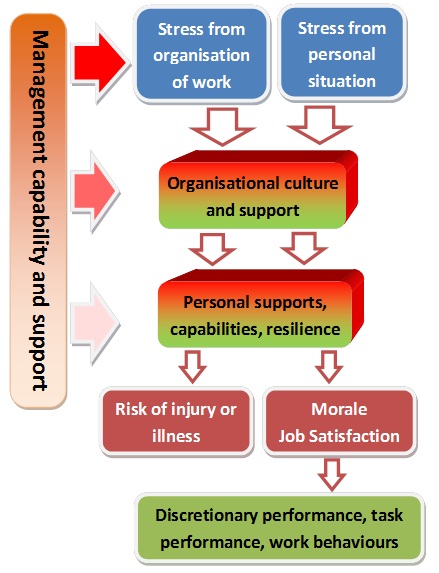Workplace stress
What leads to work related stress
Taking a simplified approach, stress can originate with work and/or personal sources. This stress can be reduced or offset by the support provided at work and/or from personal resources (family, friends etc). Equally this stress can be made worse or aggravated by lack of support from work or from staff member's personal resources. Excessive stress increases the risk of injury or illness.
It also affects personal performance and behaviour at work (and outside work). Managers can most effectively intervene by addressing work-related stressors: this is a requirement under the OHS Act. Managers can also provide support to their staff who are under stress, especially work-related stress. This may range from simply listening to a staff member and suggesting support through the Employee Assistance Program through to helping the staff member build their personal capabilities and resilience. Even when the major source of stress is personal (outside of work), managers can provide support to staff members through temporarily adjusting workloads or making other accommodations.

Risk factors for workplace stress
Eight major factors have been identified in the workplace that can drive work related stress. These are:
- Demands – such as workload, work patterns and the work environment. This includes the amount of stimulation and challenge staff get from their jobs.
- Control – such as how much say the person has in the way they do their work.
- Support – such as the encouragement, development and resources provided by the organisation, line management and colleagues.
- Relationships – such as promoting positive working relationships to avoid conflict and dealing effectively with unacceptable behaviour.
- Role – such as whether people understand their role within the organisation and whether the organisation ensures that they do not have conflicting roles.
- Change – such as how organisational change (large or small) is managed and communicated in the organisation.
- Incivility - such as tolerating or even normalising disrespectful or rude behaviours (including excessive gossip, sarcasm).
- Work-life balance - the capacity and ability of individual workers to balance stress in the workplace with stress factors in their personal life. This may vary enormously over time due to a variety of reasons including mental health issues and disability.
In Australia excessive work demands (demands) followed by workplace conflict (relationships) are the major cause of psychological injury in the workplace. This may be accentuated by a mismatch between the person's interpersonal and emotional competencies, their job skills, and the demands of the position they hold.
Work demands
| Work environment | Unpleasant or dangerous physical conditions such as crowding, noise, air pollution, or ergonomic problems. |
| Work equipment | Problems regarding the reliability, availability, suitability and maintenance or repair of equipment and facilities. |
| Task design | Lack of variety or short work cycles, fragmented or meaningless work, under-use of skills, high uncertainty. |
| Task fit | psychological fit between the employee's interpersonal and emotional competencies, their job skills, and the position they hold |
| Work load and pace | Work overload or underload, lack of control over pacing, high levels of time pressure. |
| Work schedule | Shift working, inflexible work schedules, unpredictable hours, long or unsocial hours. |
| Customer-demands | The need to hide negative emotions during interactions with clients/customers, unrealistic customer expectations, and/or verbally aggressive clients/customers. |
Control
| Decision latitude and control | Low participation in decision making, lack of control over work |
| Fairness | Perception of unfair or unjust treatment (rewards, allocation of work) |
Support
| Organisational support | Poor communication, low levels of support for problem-solving and personal development, lack of definition of organisational objectives, |
| Organisational values | Lack of family friendly policies, lack of appreciation and recognition |
| Career development | Career stagnation and uncertainty, under-promotion or over-promotion, poor pay, job insecurity, low social value to work |
Relationships
| Interpersonal relationships | Social or physical isolation, poor relationships with superiors, interpersonal conflict (including harassment and bullying), lack of social support, encouragement, sponsorship and resources provided by the organisation, line managers and colleagues. |
| Respect | Lack of civility and respect, honesty and transparency |
| Management culture | Lack of working practices and policies to avoid conflict and dealing with unacceptable behaviour, ineffective performance management (surprise, too late, contradictory, poorly managed, inappropriate responses), lack of trust |
Role
| Role ambiguity | Uncertain job expectations, lack of authority or standing, too much responsibility. |
| Role conflict | Too many "hats to wear" Conflict between manager expectations, values and priorities and personal preferences, values and priorities Out of date or irrelevant Position Description |
Change
| Organisational change | Poorly communicated and managed change processes, lack of consultation, lack of opportunity |
Incivility
| Behaviour | Tolerating or even normalising disrespectful or rude behaviours between team members, clients or other teams Engaging in or ignoring excessive gossip, criticism or sarcasm Accepting abusive behaviour from clients or other as normal. |
Work-life balance
| Home-work interface | Conflicting demands of work and home, low support at home, dual career problems. |
